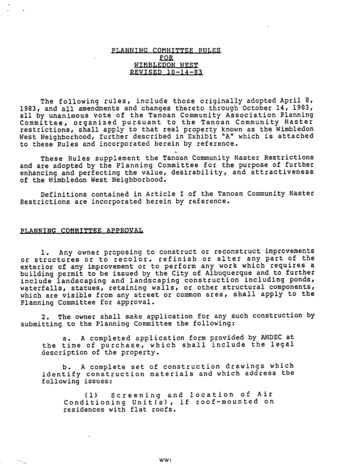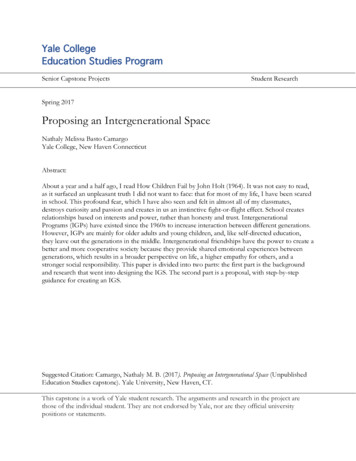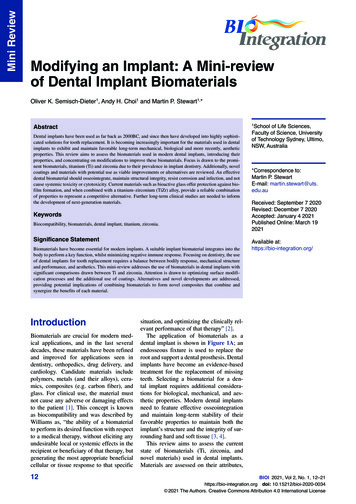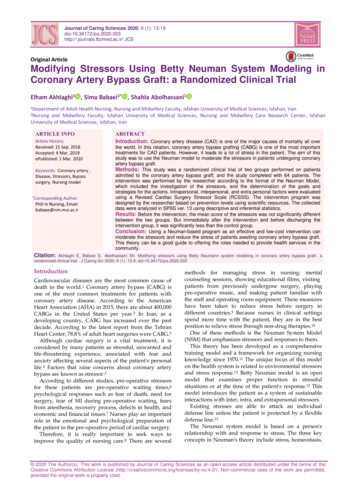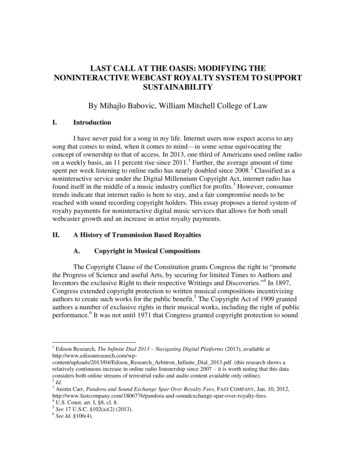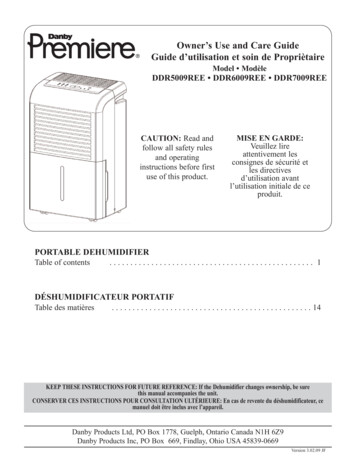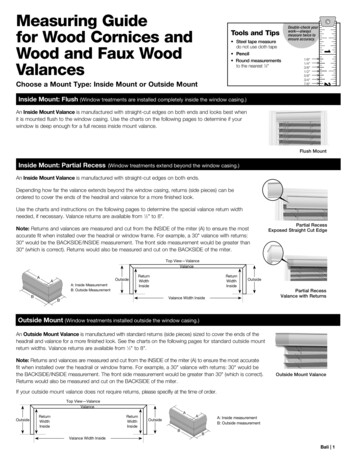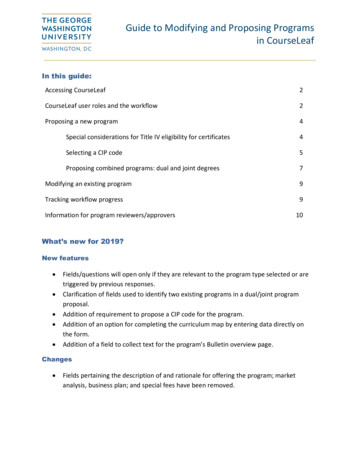
Transcription
Guide to Modifying and Proposing Programsin CourseLeafIn this guide:Accessing CourseLeaf2CourseLeaf user roles and the workflow2Proposing a new program4Special considerations for Title IV eligibility for certificates4Selecting a CIP code5Proposing combined programs: dual and joint degrees7Modifying an existing program9Tracking workflow progress9Information for program reviewers/approvers10What’s new for 2019?New features Fields/questions will open only if they are relevant to the program type selected or aretriggered by previous responses.Clarification of fields used to identify two existing programs in a dual/joint programproposal.Addition of requirement to propose a CIP code for the program.Addition of an option for completing the curriculum map by entering data directly onthe form.Addition of a field to collect text for the program’s Bulletin overview page.Changes Fields pertaining the description of and rationale for offering the program; marketanalysis, business plan; and special fees have been removed.
We’re here to assist youGina Harris, Sr. Managing Academic Editor. Gina is responsible for publishing the Bulletin. InCourseLeaf, she is the penultimate reviewer of all program request submissions. If you havequestions regarding the use and purpose of the CourseLeaf form fields, or about Bulletincontent, deadlines, and publication, contact Gina at gharris@gwu.edu, 202-994-6310. You arealways welcome to discuss your new program proposal with Gina or request a preliminaryreview of your backup documentation before submitting the proposal in CourseLeaf.Ethan Brown, CourseLeaf System Administrator. Ethan is responsible for the functioning of theCourseLeaf system, including establishing, maintaining, and troubleshooting workflows. Inaddition, Ethan offers CourseLeaf training for course and program processes on an individual orgroup basis. He also is responsible for technical issues concerning the Bulletin. Contact Ethan atewbrown@gwu.edu, 202-994-0933.Cheryl Beil, Associate Provost for Academic Planning and Assessment. Cheryl Beil is the finalreviewer/approval for all program requests. Contact Cheryl if you have questions aboutdeveloping learning outcomes or the curriculum map. cbeil@gwu.edu, 202-992-6712.Additional information is available on the Office of Academic Planning and Assessment websiteat 2Guide to Modifying and Proposing Programs in CourseLeafOffice of Academic Planning and Assessment. Updated October 2018
Accessing CourseLeafTo begin the process of modifying, proposing, or deactivating a program, log into theCourseLeaf Program Management (PM) system at next.bulletin.gwu.edu/programadmin usingyour NetID and password. If you do not already have access, contact Ethan Brown forassistance.CourseLeaf user roles and the workflowA program request submission requires an initiator to complete the form and submit it into theworkflow. Initiators often are departmental administrators but may be the department chair orother individual. The request initiator does not automatically have a role in the workflow itself.The workflow is the review and approval route for a program change request or new programproposal. Workflows are established and maintained at the department’s request by EthanBrown, CourseLeaf System Administrator, ewbrown@gwu.edu. Workflows can be customizedat the request of the school or program, but a typical workflow includes the Department Chair,Senior Associate Dean, Graduate Enrollment Management (for graduate programs only),Academic Editor, and Associate Provost for Academic Planning and Assessment.You can preview the workflow through which a course request will travel by selecting “PreviewWorkflow” from the search results screen.After a course has been submitted into the workflow, you can track its progress in the “InWorkflow” window. Completed steps appear in green, the current step is in orange.More detailed information, including the name of the individual who approved the request ateach step and on what date the request was approved, appears in the “Approval Path” window.3Guide to Modifying and Proposing Programs in CourseLeafOffice of Academic Planning and Assessment. Updated October 2018
Proposing a new programThe CourseLeaf program form is designed so that only fields that are relevant to specific proposal. Forexample, if a program is at the undergraduate level, only Concentration, Major, and Minor appear asoptions for “Type of program.”Completing the formThe following information covers the basics of what CourseLeaf users need to know in order topropose a new program. If you have questions that are not answered here, contact EthanBrown or Gina Harris for assistance.Fields Brief summary of action requested: Include a brief description of the proposal,including the department/school’s reason for the proposal.In which Bulletin will this new program or program revision first appear? Newprograms cannot be approved retroactively. Once the Bulletin has been published, newprograms with a fall semester start date cannot be added for the current academic year.Programs with a spring semester start date in the current academic year may beproposed and will be added to the current online Bulletin if approved before the springsemester begins.Level. Select Undergraduate, Graduate, or DoctoralIs this a dual program? Is this a joint program?o For both types of combined programs, you will be prompted to select theSchool/college, Department, and program for the initiating program and thesame for the associated program. The proposal will go through both workflowsat the relevant levels.o For multi-level programs, i.e., undergraduate/graduate, the “Area of study” isselected from undergraduate program options.For more detailed information on proposing joint/dual programs, see page 7.School/college initiating requestDepartmentType of programo If Level is Undergraduate, options are Certificate*, Degree, or Minoro If Level is Graduate, options are Certificate* and Degreeo If Level is Doctoral, option is Degree*Special considerations for Title IV eligibility for certificates: if Certificate isselected as type of program, you will be prompted to indicate the type of certificate4Guide to Modifying and Proposing Programs in CourseLeafOffice of Academic Planning and Assessment. Updated October 2018
and whether the program is seeking Title IV approval. It is important to note that theTitle IV review process can take up to 90 days, and requests are submitted to thefederal government only twice a year, in January and July.Area of studyo If Level is Undergraduate, options are Concentration or Majoro If Level is Graduate or Doctoral, options are Concentration or Field Title of program. Enter only the name of the Field, Major, Minor, or Concentration. Donot include the type of degree. For example, enter “History,” not “Master of Arts (orMA) in History.” Program code. This is separate from the Banner code, which is assigned by the Office ofthe Registrar. The Program code is used in CourseLeaf only and will be assigned by theAcademic Editor. CIP code. The Classification of Instructional Programs (CIP) code is a taxonomic systemthat supports the accurate tracking and reporting of fields of study and programcompletion activity. It was originally developed by the U.S. Department of Education’sNational Center for Education Statistics. All programs at GW are assigned a CIP code.Use the “Finder” to select the most appropriate CIP code for your program. If the searchfunction does not return the results you seek, you may use a relevant “CIP code family,”a two- or four-digit CIP code instead. The selected code will be reviewed and a final codeassigned when the program is approved.The Department of Homeland Security maintains a complete list of fields that fall withinthe regulatory definition of “STEM field.” These degrees allow international studentswith F-! visas a 24-month STEM optional practical training extension (OP). For moreinformation about eligibility see STEM CIP Code OPT eligible list and the STEM CIP Codelist of eligible programs. Is this degree currently offered at GW?o If “Yes” additional questions concerning the degree display. Select degreeo A drop-down menu opens with all degrees offered by GW, e.g., BA, MA, PhD. Is this degree currently offered by the School?o Delivery mode. Options include Exclusively classroom-based, Exclusively online, and aCombination of online and face-to-face (hybrid). If Exclusively classroom or Hybrid, youwill be prompted to select all applicable campuses. If this program requires courses offered in another department, which department(s)?Enter a department in the open field. If there are additional departments, use the green sign to add more. 5Guide to Modifying and Proposing Programs in CourseLeafOffice of Academic Planning and Assessment. Updated October 2018
6Admissions requirements: List all requirements for admission to the program (e.g.,course and degree prerequisites, standardized test scores, GPA requirements).Learning outcomes and Curriculum map. The Learning outcomes and Curriculum mapfunctions are interrelated.o Learning outcomes. You will be prompted to list three to five important learningoutcomes of the program (i.e., what you expect students to know and be able todo upon completion of the program). See the Setting Learning Goals section ofthe assessment website at assessment.gwu.edu/setting-learning-goals forguidance.o Curriculum map. A curriculum map covering all required courses must beprovided or updated in the following circumstances: (1) this is a new major orminor program, (2) this is an existing program and you are making changes tothe required curriculum, or (3) this is an existing program but there is no map onfile. Certificate programs require maps only if they are not associated with adegree program. Concentrations do not require maps. You may create acurriculum map directly on the CourseLeaf form, which includes step-by-stepinstructions.Alternatively, you may attach the traditional curriculum map using the mappingworksheet.Curriculum requirements for completion of program. Include course and otherrequirements (practical, skills, language, examination, thesis/dissertation, etc.) thatmust be completed for the degree. For joint and dual programs, enter only a briefstatement regarding the number of credits shared between programs.It is important to remember that the Bulletin is the University’s contract with thestudent. Once a final Bulletin has been published before the start of the fall semester,the required curriculum cannot be changed until the following academic year. Electivecourse options may be added, but not deleted.Bulletin page overview. If this is not a CCAS or doctoral program, you will be promptedto provide a brief statement for the program’s Bulletin "Overview" page. Refer tocurrent school/department pages for format and the type of information to include.Once the program has been approved and has a web page on your school/departmentwebsite, you may email the url to bulletin@gwu.edu so that it can be added to theOverview.Total number of credits/Total major credits. Enter total credits required for theprogram. For undergraduate programs, also enter total credits for the major.Save Changes or Start workflow. At the end of the form, save changes if you plan toreturn to do further work on your proposal, or submit the proposal into the workflow. IfGuide to Modifying and Proposing Programs in CourseLeafOffice of Academic Planning and Assessment. Updated October 2018
you are the initiator, but are not a reviewer in the workflow, you will not be able tomake further changes unless a reviewer rolls the proposal back out of the workflow.Proposing combined programs: joint and dual degreesJoint degrees are pursued and conferred simultaneously. The arrangement between twoschools or departments allows for a certain number of credits to be double counted, asdetermined by each school. For each joint degree there is an administrative ‘owner,’ which isthe initiator of the program request. Both schools/departments will be included in theworkflow for review.Dual degrees may be pursued and degrees/certificates conferred simultaneously orsequentially, with a specific number of credits being double counted between the twoprograms. For example, two schools/departments may agree that an undergraduate studentmay take 9 credits in graduate coursework as part of their program. The same 9 credits areapplied toward the graduate program upon matriculation.For both joint and dual degree programs, all requirements for both degrees must be fulfilled;for that reason, it is not necessary to provide detailed curriculum information in the CurriculumRequirements field on the CourseLeaf form. Enter a brief summary statement regarding theshared aspects of the program, including the number of double-counted credits and, if relevant,specific courses to be taken for those credits.Modifying an existing programBefore you begin, please note the following: Some aspects of a program cannot be changed,in which case a new program must be proposed. For existing programs, you will not be able tochange the following: Type of ProgramArea of StudyDegreeTitle of Program. This includes any change to the program title, no matter howminor.If you wish to modify any of the above fields, you must do so by proposing a new program. Tosave time, use the “Propose new from existing program” feature at top right of the form toduplicate the information on the current form.7Guide to Modifying and Proposing Programs in CourseLeafOffice of Academic Planning and Assessment. Updated October 2018
Searching for an existing program In the search field, enter one of the following:o Program code (the code assigned within the CourseLeaf system, not theBanner code).o A single word from the program title between asterisks. (Using the entireprogram title often yields poor results.)Click the green “Search” buttonSelect your program. The pre-populated program form will open.General notes regarding completing required fields for existing programsBefore you begin, please see “Fields” under “Proposing a new program,” above, to familiarizeyourself with the form fields.Searching for program historyEach time a change is approved in CourseLeaf, a new record is created showing all requestedchanges in red/green markup on the previous record. You can search for such records byclicking in the “History” check box next to the search window:Each iteration of the program may be viewed in the History section of the form by clicking onthe date of the appropriate record in the search result or in the “History” box in the right-handcolumn on the form. Individual records also can be parsed out on separate lines in the searchwindow by entering the program code in the search bar, as shown above.8Guide to Modifying and Proposing Programs in CourseLeafOffice of Academic Planning and Assessment. Updated October 2018
Tracking workflow progressPrior to submission, you can preview the workflow by selecting “Preview Workflow” on theCourseLeaf form. This will display a list of the reviewer/approvers as well as those offices orindividuals who will receive FYI notifications.Once a proposal has been submitted, you can determine its current location in the “InWorkflow” box. Completed steps are green, the current step is in orange.9Guide to Modifying and Proposing Programs in CourseLeafOffice of Academic Planning and Assessment. Updated October 2018
Information for program reviewers/approversOnly a member of the workflow review, edit, roll back, or approve a program submission onceit has been submitted into the workflow. Workflow members can view a list of all submissionsat their step at any time (program and course proposals/change requests) atnext.bulletin.gwu.edu/courseleaf/approve. Users log in with their GW Net ID and password.When a program request first arrives at the reviewer’s step, they will receive an email from“Bulletin Editor” alerting them to the fact that they have a pending program request for review.The reviewer should: Click the link in the system generated email notification.Log into the system using their GW Net ID and password.Select the appropriate role from the “Your Role” drop down menu. (Note that a roleonly appears on the list if there are courses or programs at that workflow step.) On the “Pages Pending Approval” page is a list of all programs and courses awaitingreview. Select the relevant program.If reviewing a change request, all changes appear in red (deletion) and green (addition). To viewthe edited curriculum without these markings, click on the blue “Edit” button (see below).10Guide to Modifying and Proposing Programs in CourseLeafOffice of Academic Planning and Assessment. Updated October 2018
Upon opening the record, the reviewer is presented with the following options in the upperright-hand side of the page: Edit: Opens the proposal in a new window where the reviewer can make changes beforeapproving the request. If the reviewer makes changes, they can choose to “Savechanges” to come back and complete the review at a later time, or “Start Workflow,”which sends the proposal to the next step.Rollback: Opens a dialogue box displaying a list of the initiator and any previousapprovers. If the reviewer requires additional work to be done before they will approvethe submission, they select the step to which to roll back the request. They will beprompted to enter a comment, which remains part of the record.Approve: No edits are needed and the reviewer approves the program as-is.Once the reviewer has approved the submission, it proceeds to the next step in the workflow.At that point, the reviewer cannot make further changes unless the submission is rolled back.11Guide to Modifying and Proposing Programs in CourseLeafOffice of Academic Planning and Assessment. Updated October 2018
list of eligible programs. Is this degree currently offered at GW? o If “Yes” additional questions concerning the degree display. Select degree . o A drop-down menu opens with all degrees offered by GW, e.g., BA, MA, PhD. Is this
